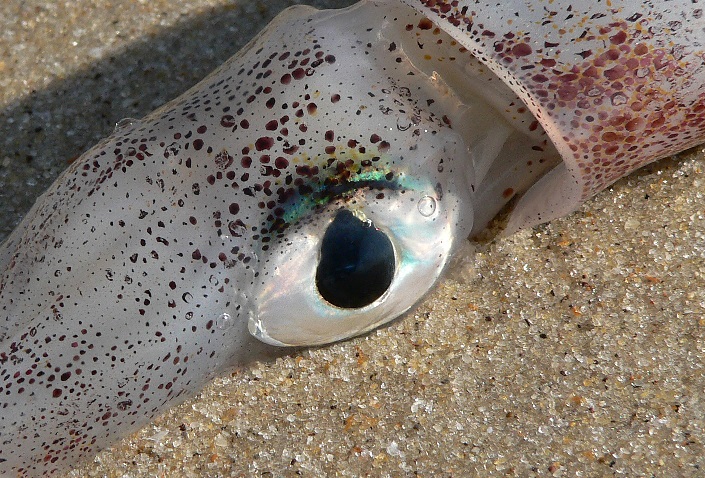Shark physiology
Article curated by Rowena Fletcher-Wood
Sharks are cartilaginous fish related to rays - and one of our most poorly understood animals. They inhabit a very alien environment to us, behave very differently and sense very differently, leading to the feeling that they are unpredictable.

Because of their vastly different environment, sharks have very different priorities for sensing than land mammals. With a history extending back at least 300 million years, the shark is older than the dinosaur. In all those years, they have had plenty of time to prime their senses to make themselves the apex predators they are today.
One of the senses that is most important to the shark is tactile sensation - the ability to detect movement and vibration. Although the shark, like us, can use touch to gain tactile information, they also have another way, a way so alien to us, that until recently we couldn’t even identify it. This is the lateral line and ampullae of Lorenzini.
The lateral line is unique to aquatic vertebrates, but very common amongst them, especially in fish. It registers turbulence and pressure changes in water when displaced by swimming animals, conceptualising them as three-dimensional hydrodynamic sensory impressions. These may be used by the fish to make spatial maps of their surroundings.
Sharks use the lateral line to detect prey, mates and to navigate in the ocean. Fish are guided into forming schools. The lateral line can even pick up the odour plumes and body smell carried by the eddies following animals through the water. In a process known as eddy chemotaxis, the perception of smell and turbulence are often combined. Scientists have even found that suppressing the lateral line in a shark (such as by administering certain antibiotics) renders them nasally blind, even though their nose is working perfectly, simply because of their reliance on using the two senses simultaneously.
Physically, the lateral line consists of a canal running between the snout and tail fin of the shark, one on either side of the body, just below the skin so that only a faint line can be seen from the outside. This canal contains fluid that connects to the seawater outside of the shark’s body via a line of tiny pores. Tiny epithelial - or hair - cells line the walls of the canal, which mechanically dislocate when they are affected by turbulence, stimulating nerve cells to send electrical pulses to the shark’s brain. In some fish, the nerve and hair cells appear on the skin surface, rather than in the canal. Along the whole line, differences in the measured pressure can be put together in the brain to picture the pressure gradient. This is similar to how our inner ears work[1].
Even more powerful and strange are the ampullae of Lorenzini. These small black pores that pepper the heads of sharks, rays and chimaeras are related to the lateral line and employ the same receptive organs. But what they sense is more sinister and fascinating than pressure changes and turbulence: these are the shark’s electroreceptors, a sensing organ specially developed to pick up the minute electrical fields established at the interfaces between living cells and seawater.
Living cells operate very much like batteries: a salt solution separated from the bloodstream or outer seawater by a membrane sets up a potential difference. This is how cells communicate with each other. Iron-rich seawater conducts the field, which changes systematically as a fish breathes through its gills, and so provides a distinct tag for the presence of nearby prey. The shark’s own body also interacts with seawater this way.
Some researchers think sharks may use electroreception to communicate with each other. They may also use it for navigation: as the magnetic field of the earth varies, mild electrical currents could be detected by the bodies of sharks to map out their journeys and help them reproduce them. This kind of electronic steering could never work in air the way it works in water; in water, salts separate into freely moving charged ions, which only occurs in air under extreme temperatures or pressures. This means land mammals would have to have much, much keener electroreception than sharks to receive any signal at all. So keen that the evolution of this sense just isn’t practical.
Sharks are currently considered the most sensitive species to electric fields. Moving their heads like metal detectors to pick up signals from their immediate surroundings, they can pick up electrical signals as low as 5 nV/cm, or five billionths of a volt 1 cm away - one million times our lower limit. However, this number is only a guess. Testing the lower limits of shark electroreception requires controlled laboratory conditions, and as such is very difficult, especially for species like Great Whites, which are not kept in captivity. We do know that sharks can detect prey buried out of sight in the sand, and that they will attack electric dipoles concealed in bundles, selecting electrode-containing bundles over empty ones a decisive number of times; however, covering the prey or electrodes with electrically insulating polyethylene renders the shark completely oblivious[2]. They will also attack metal cables or other engineering components: this is because when two metals meet, they set up a potential difference and transfer electrons across like a battery (this is called a galvanic reaction); metals are not a natural feature of the shark’s habitat, and so these signals may be mistaken for promisingly big fish. The shark’s electroreception is so sensitive that it is easier to let them attack the cables and make them bite proof than try to shield the field from their attention.
Muscle contractions typically produce signals 50 μV to 25 mV, which means that sharks can detect swimmers kilometers away. This seems like a big distance, but, in the ocean, makes electroreception - certainly accurate electroreception - a close range sense. Just think about how far sound can travel by comparison. And it isn't just muscle contractions that sharks detect with their electroreception: even when prey is paralysed and hidden, sharks can use this amazing sense to locate and attack them. This means they are picking up even more subtle signals between cells, and to do that they need to be even closer. We can use this knowledge to make some sensible guesses about the way shark senses work together to help them home in on their target: first, smells and sounds give the shark a clue to a potentially interesting item – they approach. Then they sense the turbulence, see the target and taste the body odour via eddy chemotaxis. Electroreception comes in right at the end: when the shark has spotted their prey and lunged for it, they roll their eyes back in their head, their lateral line becomes overwhelmed with data on turbulence and taste. Sharks can use their electroreception to orientate their jaws to get the best snatch.
Beneath the skin, the ampullae of Lorenzini open into thin tubes with bottle-shaped cells at the end filled with a crystalline conductive gel with the same resistivity as seawater. The ampullae work by detecting the difference between the voltage in the gel and at the pore opening. Clusters of pores on the left and right help provide the shark with a direction on the stimulus. Some fish can actually produce their own fields as well as detect them, presumably to confuse predators such as sharks and rays, which only detect them.
Until recently, we’ve known very little about how sharks sense. Although the ampullae were first discovered by the anatomist Lorenzini in 1678, their function wasn’t recognised until 1960[3]. Scientists tried all kinds of electrophysiological experiments and isolated temperature, salinity and touch as provoking a response in the ampullae. Today, researchers are still speculating about whether the ampullae can detect temperature gradients by transforming them into electrical signals[1]. Sharks, like many fish, are very sensitive to temperature, and have been reported to be able to detect changes of 0.2 °C. Other scientists are interested in the evolution, growth and development, and molecular foundation of the ampullae.
But these are not the only impressive senses identified in sharks. The more well known senses are often just as mysterious. The integrated phenomenon of eddy chemotaxis has already been discussed, but this only reflects one aspect of the sense that, in terms of brain power and space, provides the shark’s dominant input. Phenomenally sensitive, grey reef sharks have been shown to detect sea bass in parts per ten billion - equivalent to a drop of wine in a swimming pool. They are often said to detect blood kilometers away, although crucially this depends upon the concentration of blood at the site of origin.
Shark hearing is also very different from ours. They perceive sounds outside the range that we can detect, but their own range is much narrower. With their best perception around 50-150 Hz, sharks are low frequency detectors. This makes them optimised to pick up the kinds of noises produced by water turbulence: swimming, thrashing and splashing. Sharks are very good at identifying “normal” sounds for their habitat. Sounds within their range that are not normal act as warning signals. Some experts think this can be exploited to make shark deterrents; they identified a “startle response” amongst sharks exposed to a pulsed or very loud tone broken by long intervals. Hearing is also important for balance and coordination, helping the shark travel efficiently and attack accurately.
Learn more about Shark sensory biology.



When it comes to sight, there may be more variation between sharks than shared traits. Most sharks have very small eyes, but nocturnal and open ocean sharks have bigger eyes than those that live in shallow water where they receive plenty of light. Although they are relatively small, shark eyes are highly developed and quite similar to human eyes. In the brain, a huge amount of space is allocated to vision. In the great white, which has a very small brain relative to its body size, it’s visual lobes are actually dominant, suggesting that the shark is a highly visual predator. With this much brain space assigned to seeing, we might think that patterns and colours are an effective way to communicate with sharks - but perhaps not. Some researchers believe that sharks are colour blind. This hypothesis follows years of speculation and observation of behaviour, and recent research in the Royal Society Biology Letters.
In a 2012 study by Nathan Hart and colleagues from the University of Western Australia's School of Animal Biology and The Oceans Institute, wobbegong shark genes were sequenced to try to answer this question. Sequencing the photoreceptor proteins in rods and cones revealed that the wobbegongs were cone monochromats: they only had one kind. This is strong evidence that wobbegongs are colour blind, but doesn’t confirm colour blindness in other sharks species or different conjectured colour blind aquatic animals like whales, dolphins and seals.
Strong evidence also exists to suggest some shark types see colour: in particular, scientific observations of attraction or repulsion to certain colours. However, there are also contrasting observations of the nature of these responses: whilst McFadden and Johnson[4] found evidence agreeing with the allegory of “yum yum yellow” - the sharks they studied were attracted to yellow survival gear, but not black - in Wallace[5] observed bull and sand tiger sharks discriminating between coloured nettings, and found the bull sharks avoided the yellow nets. Finally, Gruber trained a lemon shark to select coloured targets[6] from a mixture of ones of the same brightness and identified the presence of cones in several shark species[7][8][9]. The evidence is conflicting, and fundamentally, nobody knows.
Some researchers think colour blindness may correlate to behavioural history and that species that have experienced a nocturnal period or frequented the depths of oceans may have lost their cone colour detectors because they were no longer needed (in contrast to the larger eyes now observed on deep sea sharks). Evolutionists and geneticists think that all sharks once had colour vision[10]. Loss of colour vision is not evolutionarily abnormal: we have even done it. Humans have an inactive photopigment that codes for wavelengths of light between 360 and 445 nm - the ultraviolet region[11].
Learn more about Whether sharks see colour.


 2
2
The physiology of vision is an incredibly intricate topic we are only just getting the hang of, mostly because we’ve just started to realise that most things don’t “see” like we do. One fantastic potential example of this is the cephalopods – octopi and squids.
For years, researchers wondered how cephalopods could camouflage themselves by imitating the colours in nature if they were colour blind, as they appeared to be. Observational data that suggested they couldn’t pick out colours of a similar shade, although they could determine the difference between black and white or differences in polarised light[12]. They were also found to have only one visual pigment, or cone.
However, more recent research suggests that cephalopods may indeed be able to see colour, it’s just that their eyes don’t do it like ours do. Whilst our pupils are round, theirs are moon-shaped. Researchers reckon that this means they can use clever focusing techniques to focus their one cone on any one colour at a time – whichever takes their fancy. If correct, this means that they can see in colour – just only one at a time. This could explain observations of behaviour and camouflage. It also provides an interesting explanation for mixed results on colour blindness in sharks: it is possible that sharks are not colour blind, but that the way they see colour (whether similar to the lens focusing method proposed for cephalopods or not) is very different from ours. This means that examining physiology and genetics looking for clues about what they see could be highly misleading – we really don’t have any idea what they can see at all.


 2
2
Whilst we have learnt a lot about shark sensation and physiology, we still don’t truly understand it. Not only can we not quite imagine what it must be like to be a shark, but sometimes the physical evidence doesn’t match with the observed behaviours. It is possible more complicated mechanisms lie behind shark sensing than we have hitherto imagined – which can only mean there are more interesting discoveries to come.
This article was written by the Things We Don’t Know editorial team, with contributions from Rowena Fletcher-Wood.
This article was first published on 2016-02-13 and was last updated on 2018-02-13.
References
why don’t all references have links?
[1] Brown, B,R., (2010) Temperature response in electrosensors and thermal voltages in electrolytes Journal of Biological Physics 36(2):121-134 DOI: 10.1007/s10867-009-9174-8
[2] Kalmijn, A. J., (1971) The Electric Sense of Sharks and Rays. Journal of Experimental Biology, 55, 371-383
[3] Murray, R,W., (1960) Electrical Sensitivity of the Ampullæ of Lorenzini Nature 187(4741):957 DOI: 10.1038/187957a0
[4] McFadden, E. B., and C. S. Johnson., (1971) Colour and reflectivity of sea survival equipment as related to shark attack. Abstr. Aerospace Med. Meeting, Houston, Texas.
[5] Wallace, L., (1972) Reactions of the Sharks Carcharhinus Leucas (Müller & Henle) and (Odontaspis Taurus Rafinesque) to Gill Net Barriers Under Experimental Conditions. Oceanographic Research Institute
[6] Gruber, Samuel H., (1975) Duplex vision in the elasmobranchs: histological, electrophysiological and psychophysical evidence. Vision in fishes.Springer US. 525-540
[7] Gruber, S. H. (1970). The physiology of vision in the lemon shark, Negaprion brevirostris (poey): A behavioral analysis (Doctoral dissertation).
[8] Gruber, S. H., D. 1 .. Hamasaki, and C. 0. B. Bridges. 1963. ‘Cones in the retina of the lemon shark (Negaprionbrevirostris). Vision Research’. 3:397-399
[9] Hamasaka, D. I., and S. H. Gruber. 1965. shark Ginglymostomacirratum and the lviar. Sci. 15(4): 1051-1059
[10] Cohen, Joel L. 'Vision in Elasmobranchs: Histology of the Retina and Erg Spectral Sensitivity'. Diss. 1972
[11] Jacobs, G,H., (2009) Evolution of colour vision in mammals Philosophical Transactions of the Royal Society B: Biological Sciences 364(1531):2957-2967 DOI: 10.1098/rstb.2009.0039
[12] Hanlon, RT, and Messenger, JB (1996) ‘Cephalopod Behaviour’. Cambridge: Cambridge University Press
Recent Shark physiology News
Get customised news updates on your homepage by subscribing to articles












